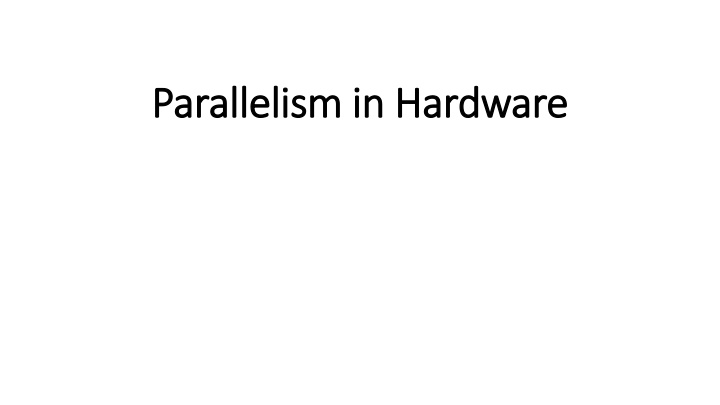
Hardware Parallelism and Cache Memory
Explore the concepts of hardware parallelism, von Neumann architecture, cache memory, principle of locality, and cache management techniques like write-through and write-back. Learn how hardware supports parallelism and improves processing efficiency.
Download Presentation

Please find below an Image/Link to download the presentation.
The content on the website is provided AS IS for your information and personal use only. It may not be sold, licensed, or shared on other websites without obtaining consent from the author. If you encounter any issues during the download, it is possible that the publisher has removed the file from their server.
You are allowed to download the files provided on this website for personal or commercial use, subject to the condition that they are used lawfully. All files are the property of their respective owners.
The content on the website is provided AS IS for your information and personal use only. It may not be sold, licensed, or shared on other websites without obtaining consent from the author.
E N D
Presentation Transcript
Parallelism in Hardware Parallelism in Hardware
So Far So Far Parallel programming using OpenMP constructs Dependence analyses to identify parallelism Question: How does hardware support parallelism?
von Neumann architecture von Neumann architecture
Improvements on von Improvements on von Neumann architecture Neumann architecture Major Improvements: Cache memory Virtual memory Low level parallelism
Cache Memory Cache Memory An intermediate small, faster memory between CPU and main memory. CPU can access cache memory significantly faster than main memory. CPU Cache Main Memory
Principle of Locality Principle of Locality Cache memory improve temporal and spatial locality. Temporal locality. After accessing one memory location (for instruction or data) computation will access the same location in near future. Spatial locality. After accessing one memory location (for instruction or data) computation will consecutively access a nearby location. Example: int a[1000]; . . . sum = 0; for (i = 0; i < 1000; i++) sum += a[i];
Accessing Cache Memory Accessing Cache Memory Cache Hit and Miss When a cache is checked for information and the information is available, it s a cache hit. Otherwise, it s a cache miss. Cache Block and Cache Lines Based on principles of locality a memory access will effectively operate on a blocks of memory instead of an individual location.
Write Write- -through and Write through and Write- -back Cache back Cache Write-through cache writes the data back to memory as soon as it is written to the cache. Write-back cache The data isn t written immediately. (1)Mark the updated data in the cache as dirty. (2) When the cache line is replaced by a new cache line from memory, the dirty line is written to memory.
Cache mappings Cache mappings Decided by cache associativity Fully associative cache: a new line can be placed at any location in the cache. Direct-mapped cache. each cache line has a unique location in the cache to which it will be assigned. n-way set associative (Intermediate schemes). each cache line can be placed in one of n different locations in the cache.
Example Example Cache associativity Tradeoff: Direct mapped cache: good best-case time but unpredictable in worst case Fully associative cache: the best miss rates, but practical only for a small number of entries Different cache replacement policies for n-way associative caches
Effect of Cache Memory on Programs Effect of Cache Memory on Programs double A[MAX][MAX], x[MAX], y[MAX]; . . . /* Initialize A and x, assign y = 0 */ . . . /* First pair of loops */ for (i = 0; i < MAX; i++) for (j = 0; j < MAX; j++) y[i] += A[i][j] * x[j]; . . . /* Assign y = 0 */ /* Second pair of loops */ for (j = 0; j < MAX; j++) for (i = 0; i < MAX; i++) y[i] += A[i][j] * x[j]; C stores two-dimensional arrays in row-major order. MAX=4 First pair of loops: 4 cache misses Second pair of loops: 16 cache misses Result: the first pair of loops are faster
Virtual Memory Virtual Memory Main memory may not suffice to store: - a large program, - a program with large data size, - multiple programs and data in multitasking OS Solution: Virtual memory. - main memory functions as a cache for secondary storage - main memory access is order of thousands times faster than secondary memory - virtual memory abstracts the physical addresses of the secondary storage
Page Page - - - virtual memory operates on pages (blocks of data and instructions) pages are of a fixed page size (4 to 16 KB) pages contain virtual addresses, not physical addresses of secondary storage - Page table translates virtual addresses to physical addresses virtual address = virtual page number + byte offset in the page Let a virtual address is of 32 bit and page size is 4 KB = 4096 bytes. Each byte in the page is identified with 12 bits, since 2^12 = 4096
Virtual Memory and TLB Virtual Memory and TLB Virtual memory tradeoff: Virtual memory to physical memory computation increases the runtime Solution: translation-lookaside buffer or TLB (similar to cache memory) TLB caches a few entries from the page table in very fast memory. Principle of spatial and temporal locality is applicable Improves the page table access speed significantly Page fault: the page is not in main memory, it is in secondary storage. Similar to cache miss.
References References Chapter 2 An Introduction to Parallel Programming by Peter Pacheco.





















